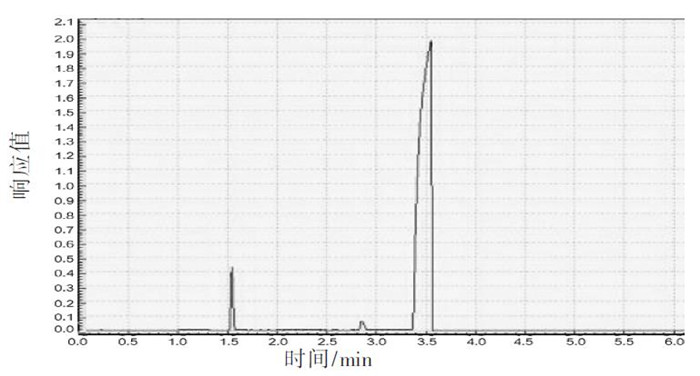Preliminary study on flammability of diacetone alcohol products
-
+ English摘要:目的 验证双丙酮醇作为易燃液体在《危险化学品目录(2015版)》和《危险货物品名表》中列名管理是否合理,为双丙酮醇的危险性重新分类和其产品安全管理调整提供参考依据。方法 采用测试双丙酮醇的闭杯闪点并做不确定度评定的方法,评估其易燃性;使用气相色谱-质谱联用法,分析双丙酮醇产品及其杂质含量;测试杂质含量不同的双丙酮醇模拟产品的闭杯闪点,以评估杂质对双丙酮醇产品易燃性的影响。结果 质量分数99.0%的双丙酮醇闭杯闪点测试结果U95为(63.6 ±0.8)℃,合成不确定度的有效自由度νeff=9.8,可能不属于易燃液体;模拟产品测试表明双丙酮醇中丙酮质量分数分别 < 4%、4%~9%、> 9%时,双丙酮醇产品分别被分类为易燃液体类别2、类别3和类别4,丙酮可能是导致双丙酮醇产品具高度易燃性的主要原因。结论 将双丙酮醇作为易燃液体,在《危险化学品目录(2015版)》和《危险货物品名表》列名管理是否合适,有待进一步研究。可通过减少丙酮杂质含量,降低其易燃危险性。
-
不良妊娠结局(adverse pregnancy outcomes)是指正常活产以外的其他妊娠结局,主要包括自然流产、死胎死产、异位妊娠、畸胎等,其发生率因地域和目标人群各异而报道不一,约占妊娠结局的5% ~ 20% [1-3]。近年来,我国肿瘤发病率日益上升,抗肿瘤药物(antineoplastic drugs,ADs)也随之不断开发与应用,虽改善了肿瘤患者的生存质量,但也给职业接触ADs的医护人员带来了潜在的职业危害[4]。中华人民共和国国家统计局指出,中国约1 069万医护人员有可能暴露于危险性药物环境中,且数量还在增加[5]。大量研究表明,多数ADs为细胞毒性制剂,具有致突变性、致癌性及致畸性,职业接触ADs可损伤医护人员生殖功能[6-8]。在处置Ads的过程中,药物可通过皮肤、呼吸道及消化道等途径侵入人体,并在体内潜伏,影响卵子及精子成长,引发染色体畸变,损伤卵巢功能,导致医护人员不良妊娠结局的发生率显著增高[7-9]。自1979年Flack等[10]在处理接触ADs的医护人员尿液中检测出致突变物质以来,有关医护人员ADs职业接触与不良妊娠结局关联性的流行病学研究也逐渐增多,但结论并不一致,证据仍不充分。因此,本研究拟在调查深圳市职业接触ADs医护人员不良妊娠结局现状的基础上,分析其不良妊娠结局发生的影响因素,为改善医护人员职业安全现状提供切实可行的建议。
1. 对象与方法
1.1 对象
选取广东省深圳市3家三级甲等医院已婚、有生育史的女性医护人员为研究对象,以孕期或孕前曾从事接触ADs工作1年以上者为接触组。接触组纳入标准:①正式注册在岗的医护人员;②接触ADs时间≥ 1年;③孕前或孕期在肿瘤相关科室工作;④已婚且至少有过1次妊娠经历;⑤自愿参加本课题研究。
对照组纳入标准:①正式注册在岗的医护人员;②未接触过ADs的其他科室医护人员;③和接触组研究对象在同一医院或地区;④已婚且至少有过1次妊娠经历;⑤自愿参加本课题研究。
两组研究对象排除标准:①最近6个月内有放射线暴露史;②有吸烟、饮酒习惯;③未婚及无妊娠经历;④既往患有恶性肿瘤、血液系统疾病、免疫系统疾病以及无法控制的慢性疾病;⑤调查阶段未在岗。
1.2 方法
1.2.1 调查方法
本次调查在深圳市3家三级甲等公立医院进行,提前与医院相关科室负责人取得联系,沟通完善后由6名调查人员根据相关负责人提供的名单对医护人员进行初步筛查,对调查对象发放调查问卷,最终发放问卷242份,有效问卷235份,有效回收率97.1%,其中接触组119份,对照组116份。
1.2.2 调查工具
采用《肿瘤相关科室护士抗癌药物职业暴露情况调查问卷》 [11]进行调查,问卷条目的内容效度CVI指数为0.846 ~ 1.000,调查水平的内容效度CVI指数为0.923,Cronbach’s α系数为0.738,重测信度为0.662。问卷分为两个部分,第一部分主要调查研究对象一般资料:年龄、工龄、职称、学历、身高、体重及生育状况等;第二部分为行为自评和健康自评,共45个条目,从医护人员的认知、行为和环境等三方面出发,评估医护人员对处理Ads的相关健康及防护知识掌握情况,探寻医护人员的职业接触风险。
1.2.3 质量控制
在调查前,对参与本次调查的调查员进行统一培训。问卷发放前,向研究对象解释本研究的目的、意义,并介绍问卷填写方法及要求,被调查者需在安静的环境下20 min内独立完成调查,所有问卷现场填写回收。调查人员认真核对问卷,确保问卷质量,并及时核对空项、漏项,剔除不合格问卷(缺失条目大于20%的问卷)。对问卷编号后双人录入数据,进行逻辑检错及程序核对,确保数据录入准确性。
1.2.4 统计学分析
使用EpiData 3.1软件建立数据库,采用SPSS 26.0软件对数据进行统计分析。计量资料采用Shapiro-Wilk test检验对数据进行正态性分析,符合正态分布的采用均数±标准差(x ± s)表示,两组间差异比较采用两独立样本t检验,不符合正态分布的以中位数(四分位数)[M(P25,P75)]表示,组间比较采用Wilcoxon符号秩和检验;计数资料采用频数和百分比表示,组间比较采用χ2检验;采用二元logistic回归分析接触组发生不良妊娠结局的影响因素。检验水准α = 0.05。
2. 结果
2.1 一般资料
接触组119人,孕次153次,对照组116人,孕次156次,两组研究对象的年龄、BMI、工龄、孕次、学历、职称、有无被动吸烟、有无服用维生素补充剂及有无月经异常等一般资料比较,差异均无统计学意义(P > 0.05),具有良好的可比性。见表 1。
表 1 两组研究对象人口学资料分析[例数(构成比/%)] 调查项目 接触组(n = 119) 对照组(n = 116) Z、t或χ2值 P值 年龄/岁① 31.64(29.18,33.99) 30.81(26.23,34.67) - 1.569 0.117 工龄/年① 9.71(7.06,13.07) 8.38(4.43,14.84) - 1.286 0.198 孕次① 1.00(1.00,2.00) 1.00(1.00,2.00) - 0.874 0.382 BMI/(kg/m2)② 21.00 ± 2.65 21.30 ± 2.69 - 0.843 0.400 学历 3.791 0.052 本科及以上 97(80.7) 82(70.7) 大专及以下 22(19.3) 34(29.3) 职称 0.203 0.652 中级及以上 36(30.3) 32(27.6) 初级及以下 83(69.7) 84(72.4) 被动吸烟 0.934 0.334 有 37(31.1) 43(37.1) 无 82(68.9) 73(62.9) 服用维生素补充剂 0.732 0.392 有 79(66.4) 83(71.6) 无 40(33.6) 33(28.4) 月经异常 3.325 0.068 是 56(47.1) 41(35.3) 否 63(52.9) 75(64.7) 注:①不符合正态分布计量资料,以M(P25,P75)表示;②符合正态分布计量资料,以(x ± s)表示。 2.2 两组医护人员不良妊娠结局比较
不良妊娠结局包括自然流产、胚胎停止发育、死胎、畸胎。一名医护人员发生一次或一种以上不良妊娠结局,都计为一次。接触组22名医护人员不良妊娠结局发生率为18.5%;对照组3名医护人员不良妊娠结局发生率为2.6%,接触组发生不良妊娠结局的风险是对照组的8.543倍(P < 0.001)。见表 2。
表 2 两组研究对象不良妊娠结局比较[例数(发生率/%)] 组别 例数 自然流产 胚胎停止发育 畸胎 死胎 不良妊娠结局 接触组 119 13(10.9) 11(9.2) 4(3.4) 1(0.8) 22(18.5) 对照组 116 2(1.7) 1(0.9) 0(0) 0(0) 3(2.6) χ2值 8.321 8.516 2.212 15.623 P值 0.004 0.004 0.137 1.000 < 0.001 OR值 6.991 11.713 8.543 95%CI值 1.541 ~ 31.708 1.487 ~ 92.258 2.481 ~ 29.415 2.3 接触组医护人员不良妊娠结局的单因素分析
以是否发生不良妊娠结局将接触组进行分组,对接触组医护人员相关因素进行单因素分析,结果显示,不良妊娠结局的发生与医护人员的ADs接触年限、是否参与医院开设课程、科室培训及同事间交流学习ADs相关危害知识,课程培训后是否实施监督、是否熟悉ADs外溢后的紧急处理方案及上报流程、处理ADs时是否使用N95及以上口罩、佩戴双层乳胶手套及防护服等有关,差异有统计学意义(P < 0.05)。见表 3。
表 3 接触组医护人员不良妊娠结局的单因素分析[例数(构成比/%)] 调查项目 不良妊娠结局 Z、t、χ2值 P值 有(n = 22) 无(n = 97) 年龄/岁① 33.45
(28.46,35.99)31.03
(29.22,33.45)- 1.595 0.111 工龄/年① 12.50
(7.06,15.58)9.19
(6.85,12.23)- 1.886 0.059 孕次① 1.00(1.00,1.25) 1.00(1.00,2.00) - 0.669 0.503 BMI/(kg/m2)② 20.30 ± 3.34 21.01 ± 2.49 0.022 0.982 ADs接触年限① 9.92
(7.75,11.87)3.19(1.28,7.09) - 4.306 0.000 月经异常 0.028 0.867 是 10(17.9) 46(82.1) 否 12(19.0) 51(81.0) 学历 0.069 0.792 本科及以上 17(17.5) 80(82.5) 大专及以下 5(22.7) 17(77.3) 职称 0.478 0.489 中级及以上 8(22.2) 28(77.8) 初级 14(16.9) 69(83.1) 被动吸烟 0.350 0.554 有 14(17.1) 29(78.4) 无 8(21.6) 68(82.9) 服用维生素补充剂 0.644 0.422 有 9(22.5) 66(83.5) 无 13(16.5) 31(77.5) 所在医院 3.985 0.046 肿瘤专科医院 8(12.1) 58(87.9) 非肿瘤专科医院 14(26.4) 39(73.6) 参与医院学习ADs危害知识课程 13.213 < 0.001 是 6(8.2) 67(91.8) 否 16(34.8) 30(65.2) 参与科室学习ADs危害知识培训 7.031 0.008 是 15(14.4) 89(85.6) 否 7(46.7) 8(53.3) 同事间交流学习ADs危害知识 11.820 0.001 是 4(6.6) 57(93.4) 否 18(31.0) 40(69.0) 课程培训后实施监督 5.054 0.025 是 13(13.8) 81(86.2) 否 9(36.0) 16(64.0) 认为有必要加强ADs知识培训 1.963 0.161 是 17(16.2) 88(83.8) 否 5(35.7) 9(64.3) 身体暴露部位意外接触ADs经历 1.799 0.180 有 13(23.6) 42(76.4) 无 9(14.1) 55(85.9) 熟悉ADs外溢后的紧急处理方案及上报流程 7.211 0.007 是 12(13.2) 79(86.8) 否 10(35.7) 18(64.3) 熟悉针对ADs发生暴露的紧急处理装备 3.773 0.052 是 8(14.6) 82(85.4) 否 14(34.8) 15(65.2) 熟悉标准化的ADs配制流程 0.238 0.626 是 17(19.5) 70(80.5) 否 5(15.6) 27(84.4) 认为应限制孕妇或哺乳期工作人员接触ADs 1.291 0.256 是 10(14.9) 57(85.1) 否 12(23.1) 40(76.9) 认为现在的职业接触ADs环境安全 1.917 0.166 是 3(10.0) 27(90.0) 否 19(21.3) 70(78.7) 处理ADs时使用N95及以上口罩 15.942 < 0.001 是 4(6.0) 63(94.0) 否 18(34.6) 34(65.4) 处理ADs时使用双层乳胶手套 14.338 < 0.001 是 2(3.7) 52(96.3) 否 20(30.8) 45(69.2) 处理ADs时使用护目镜 1.704 0.192 是 11(24.4) 34(75.6) 否 11(14.9) 63(85.1) 处理ADs时穿戴防护服 4.122 0.042 是 5(10.0) 45(90.0) 否 17(24.6) 52(75.4) 注:①不符合正态分布计量资料,以M(P25,P75)表示;②符合正态分布计量资料,以(x ± s)表示。 2.4 接触组医护人员不良妊娠结局的多因素分析
以是否发生不良妊娠结局作为响应变量,以单因素分析中有统计学意义的因素为预测变量,进行二元logistic回归分析,结果显示:ADs接触年限增加是医护人员不良妊娠结局的危险因素(OR = 1.181,95%CI = 1.004 ~ 1.389,P < 0.05)。参与医院开设课程(OR = 0.185,95%CI = 0.036 ~ 0.954)、科室培训(OR = 0.056,95%CI = 0.005 ~ 0.633)及同事间交流学习ADs相关危害知识(OR = 0.094,95%CI = 0.015 ~ 0.605)、处理ADs时使用N95及以上口罩(OR = 0.127,95%CI = 0.021 ~ 0.782)、佩戴双层乳胶手套(OR = 0.071,95%CI = 0.008 ~ 0.612)是发生不良妊娠结局的保护因素(P < 0.05)。见表 4。
表 4 接触组医护人员不良妊娠结局的多因素logistic回归分析影响因素 β值 标准误 Wald χ2值 P值 OR值 95%CI值 常量 3.022 1.497 4.073 0.044 20.524 接触ADs年限(数值变量) 0.167 0.083 4.043 0.044 1.181 1.004 ~ 1.389 肿瘤专科医院(参照:非肿瘤专科医院) 2.209 1.233 3.208 0.073 9.107 0.812 ~ 102.150 参与医院开设课程学习ADs危害知识(参照:否) - 1.688 0.837 4.067 0.044 0.185 0.036 ~ 0.954 参与科室培训学习ADs危害知识(参照:否) - 2.876 1.234 5.428 0.020 0.056 0.005 ~ 0.633 同事间交流学习ADs相关危害知识(参照:否) - 2.366 0.950 6.198 0.013 0.094 0.015 ~ 0.605 课程培训后实施监督(参照:否) - 0.491 1.101 0.199 0.656 0.612 1.416 ~ 9.971 熟悉ADs外溢后的紧急处理方案及上报流程(参照:否) - 1.518 0.887 2.925 0.087 0.219 0.039 ~ 1.248 处理ADs时使用N95及以上口罩(参照:否) - 2.063 0.927 4.949 0.026 0.127 0.021 ~ 0.782 处理ADs时使用双层乳胶手套(参照:否) - 2.651 1.102 5.783 0.016 0.071 0.008 ~ 0.612 处理ADs时穿戴防护服(参照:否) 0.278 0.822 0.115 0.735 1.321 0.264 ~ 6.612 3. 讨论
自20世纪40年代使用烷基化物治疗肿瘤以来,具有生物作用的ADs迅速增多,ADs具有非选择性,在杀伤肿瘤细胞的同时,对正常组织细胞也有损伤作用,尤其是对增殖活跃的生殖细胞、黏膜、毛囊、胎儿。孕前或孕后接触ADs均可损伤生殖细胞或胎儿,导致自然流产、死产及畸胎等不良妊娠结局的发生[7, 12-13]。本次对深圳市3家医疗机构的调查研究发现,接触组不良妊娠结局的发生率为18.5%,高于对照组(2.6%)(P < 0.001),与其他相关研究[14-17]结果一致,提示职业接触ADs可在一定程度上导致医护人员不良妊娠结局的风险增加。赵树芬等[18]对京津地区5家医院已婚且有生育史的590名护士的妊娠情况的调查结果指出,孕前及孕期职业接触ADs的护士其早产和自然流产率分别为5.3%和13.5%,高于对照组早产率(2.4%)和自然流产率(7.7%)。李亚洁等[19]对广东省职业接触ADs医护人员的问卷调查结果发现,医护人员职业接触ADs与发生不良妊娠结局紧密相关,与本研究结果一致。
ADs能够引起生殖系统尤其是卵巢损伤,长期低剂量接触可对医护人员生殖功能造成影响,导致生育能力降低,有的甚至对生殖系统造成不可逆的永久性损害[20]。在本次调查中发现,医护人员接触ADs的时间越长,其发生不良妊娠结局的风险越高(OR = 1.181,P < 0.05)。谢金辉等[21]通过衡量接触水平并进行接触-效应关系的趋势χ2检验发现,医护人员不良妊娠结局的发生随接触水平的增加而增加,呈一定的接触-效应关系。可见,医护人员接触ADs时间越长,其累积的毒性剂量更多。
职业安全意识的强弱可直接影响医护人员的防护依从性,接受安全教育培训越频繁的医务人员其职业防护态度、防护行为就越好[22-23]。本次调查结果显示,接触组中有61.3%的人员通过医院开设的课程学习ADs相关危害知识、87.4%的人员通过科室培训学习、51.3%的人员通过同事交流间学习,高达88.2%的医护人员认为很有必要在院内加强ADs暴露相关知识的培训。多因素logistic回归分析发现,参与医院开设课程、科室培训及同事间交流学习ADs相关危害知识,是发生不良妊娠结局的保护因素(P < 0.05),与刘利莎[24]的研究结果一致。定期培训可提高医护人员的职业防护能力,增强防护意识,降低职业危害的发生。因此,医疗卫生管理者应切实把职业安全教育放在首位,采取多途径、多方法、多手段的方式制定专科培训计划,加强医护人员ADs职业安全防护教育。
由于我国肿瘤专科起步晚,现阶段尚无完善的ADs防护制度,医院对ADs职业安全管理重视度不高。既往调查发现,我国仅有部分医院采用了集中式管理模式,设有静脉配置中心(PIVAS),大多数医院采用的是落后的分散管理模式[25-27]。在本次调查的3家医院中,仅1家医院为肿瘤专科医院,采用了ADs集中管理模式,设有PIVAS,其余两家医院均为综合性三甲医院,采用分散式管理模式。相比集中管理模式,分散式管理模式不利于控制ADs的污染范围,且扩大了ADs的接触人群[28]。本次问卷调查显示,近50%的医护人员在工作中有过身体暴露部位意外接触到ADs的经历,75.6%的人员认为现在的职业接触ADs的环境不安全。针对ADs的管理防护,北美及欧洲片区发展早,较为重视和完善,目前多数医院已采用集中管理模式,建立完成PIVAS,并使用封闭系统转移装置减少ADs对环境的污染,维护医护人员职业安全[29]。
尽量减少与ADs的接触是医护人员接触ADs时应遵循的原则,大量国内外指南[30-32]要求医护人员在接触ADs时应佩戴完备的个人防护装备(personal protection equipment,PPE),然而,仍有部分医护人员依从性较差,防护意识淡薄[33]。本次调查结果也显示,接触组医护人员在处理ADs时,仅56.3%的人员使用N95及以上口罩,45.3%使用双层乳胶手套,37.8%佩戴护目镜,42.0%穿戴防护服,大部分医护人员未按照国际指南推荐佩戴PPE。分析其原因主要有以下3个方面:(1)医护人员自身防护意识欠缺,未认识到职业健康的重要性,防护依从性较差;(2)医院防护用具供应不足,医护人员即使有较好的防护意识,也难以避免职业暴露;(3)医院管理不到位,监督力度不够,对医护人员职业安全培训不足,导致医护人员自主意识缺乏,忽视个人防护的重要性。多因素logistic回归分析发现,处理ADs时使用N95及以上口罩,佩戴双层乳胶手套是医护人员不良妊娠结局的保护因素(P < 0.05)。Lawson等[34]对40 000多名医护人员进行的健康状况横断面研究指出,使用防护手套及防护服是医护人员接触ADs的最低防护装备,且强调进一步教育和培训的重要性。
2019年《国务院关于实施健康中国行动的意见》 [35]提出“职业健康保护行动”,强调职业健康的重要性。国家对职业健康及生育发展均十分重视。虽然本次调查结果显示职业接触ADs可造成医护人员不良妊娠结局的风险增加,但该职业危害并不是不可避免的。管理者应提高重视程度,将职业健康放在首位。(1)积极改善医院ADs管理模式,尽早建立PIVAS,采用先进的防护设施设备,实现科学安全的集中管理;同时也不可忽视对医护人员的职业健康教育。(2)对于长期接触ADs的医护人员应建立健康档案,定期进行常规体检,包括血常规、肝肾功能、B超等,必要时可增加特异性体检项目,如彗星、微核及免疫功能等相关检查,以期及时发现异常。(3)避免特殊人群接触ADs,如孕期、哺乳期及备孕期医务人员,将她们暂时调离工作岗位,把职业危害降至最低。医护人员自身也应树立“主人翁”意识,在工作中规范配制ADs,合理使用防护用具,主动了解ADs的职业危害,提高防护依从性,减少不必要的职业危害。
本研究的局限性:(1)本研究为横断面研究,仅对深圳市3家医院的医护人员进行调查,样本量不大,并未考虑地域及目标人群的差异,研究结果可能存在一定的偏倚。(2)本研究结果只可间接指出职业接触ADs会增加医护人员不良妊娠结局的风险,不可明确得出ADs职业暴露与医护人员不良妊娠结局之间的直接联系,故相关结论仍有待开展更高质量的研究进一步佐证。
作者声明 本文无实际或潜在的利益冲突 -
表 1 双丙酮醇闭杯闪点测试结果
(闭杯闪点/℃) 序号 第1次 第2次 第3次 1 64.0 63.0 65.0 2 65.5 63.5 64.5 3 65.0 64.0 64.0 4 64.5 63.5 63.5 5 63.5 63.5 63.5 6 62.5 63.5 62.5 7 63.5 62.5 62.5 8 63.5 63.5 62.5 9 63.5 63.5 63.5 10 63.5 63.5 62.5 表 2 含丙酮的双丙酮醇模拟产品易燃性
序号 质量分数/% 闭杯闪点/℃ 易燃性类别 1 2 63.0 4 2 3 63.0 4 3 4 41.0 3 4 5 38.0 3 5 6 34.0 3 6 7 30.0 3 7 8 28.0 3 8 9 24.0 3 9 10 17.0 2 -
[1] 国际化学品安全规划署, 欧洲联盟委员会. 国际化学品安全卡(上册)[M]. 中国化工学会, 中国石化北京化工研究院, 译. 北京: 化学工业出版社, 2014: 639. [2] 化学工业出版社. 中国化工产品大全(下卷)[M]. 4版. 北京: 化学工业出版社, 2011: 142. [3] 化学工业出版社. 中国化工产品大全(中卷)[M]. 4版. 北京: 化学工业出版社, 2011: 60. [4] 中华人民共和国国家安全生产监督管理总局. 国家安全监管总局办公厅关于印发危险化学品目录(2015版)实施指南(试行)的通知[A]. 2015-09-02. [5] 中华人民共和国国家质量监督检验检疫总局, 中国国家标准化管理委员会. 危险货物品名表: GB 12268-2012[S]. 北京: 中国标准出版社, 2012. [6] United Nations. Recommendations on the transport of dangerous goods model regulations[S]. 21st ed. New York & Geneva: United Nations Publication, 2019.
[7] BUDAVARI S. The merck index: an encyclopedia of chemicals, drugs and biologicals[M]. 11th ed. Rahway, NJ: Merck and Co., Inc., 1989: 468.
[8] CLAYTONG D, CLAYTON F E. Patty's industrial hygiene and toxicology. volume 2a, 2b, 2c: toxicology[M]. 3rd ed. New York: John Wiley Sons, 1981-1982: 4659.
[9] 中华人民共和国国家质量监督检验检疫总局, 全国法制计量管理计量技术委员会. 测量不确定度评定与表示: JJF 1059.1-2012[S]. 北京: 中国标准出版社, 2012. [10] 中华人民共和国国家质量监督检验检疫总局, 国家标准化管理委员会. 化学品分类和标签规范第7部分: 易燃液体: GB 30000.7-2013[S]. 北京: 中国标准出版社, 2014. [11] United Nations. Globally harmonized system of classification and labeling of chemicals[S]. 8th ed. New York & Geneva: United Nations Publication, 2019.
[12] 中华人民共和国国家安全生产监督管理总局, 工业和信息化部, 公安部, 等. 危险化学品目录(2015版)[A]. 2015-02-27. [13] United Nations. United nations. manual of tests and criteria[S]. 7th ed. New York & Geneva: United Nations Publication, 2019.
[14] American Society of Testing International. Standard test methods for flash point by Pensky-Martens closed cup tester: ASTM D 93-2019[S]. West Conshohocken: ASTM International, 2019.
[15] 陈黎明, 陈永康, 张笑旻. 苯甲醚闭杯闪点的测定及不确定度评定[J]. 上海计量测试, 2019, 46(1): 41-42;44. https://www.cnki.com.cn/Article/CJFDTOTAL-SJLC201901016.htm [16] 赵晨阳. 化工产品手册有机化工原料[M]. 6版. 北京: 化学工业出版社, 2016: 218;224. -
期刊类型引用(3)
1. 周倩,肖青青,李佳,黄小红. 接触抗肿瘤药物对医护人员的健康损害及防护研究进展. 职业卫生与应急救援. 2024(01): 127-131 .  本站查看
本站查看
2. 周倩,肖青青,成金桃,张双飞,黄小红. 格林模式在医护人员职业防护中的应用进展. 职业卫生与应急救援. 2024(04): 546-550 .  本站查看
本站查看
3. 何兴丽,徐红英. 女性医护人员抗肿瘤药物职业暴露与防护现状. 中国工业医学杂志. 2024(04): 380-383 .  百度学术
百度学术
其他类型引用(0)





 下载:
下载:

